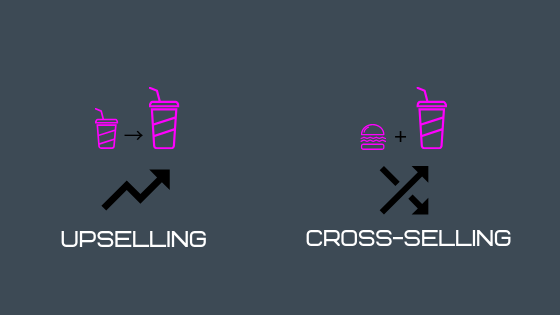Using upselling and cross-selling techniques for your print business is highly effective in boosting sales. Many businesses use these tactics and incorporate these concepts into their every day business model.
Before we dive into how to successfully upsell and cross-sell for your business, let’s go over these terms briefly and differentiate the two.

Upselling vs. Cross-selling: What’s the Difference?
Upselling is a sales technique that encourages customers to spend more buy purchasing an upgraded or premium version of an original product. Businesses will try to create an up-sale by influencing a customer to spend more on a product that is essentially the same as the original; for example, when you place an order at McDonald’s and you’re asked if you want to make it a combo.
Cross-selling provides the option for customers to add more items to their initial purchase. These add-on items usually complement the original product of purchase, which convinces the customer that the product will work better with other suggested products.
So how do you successfully master these techniques?
We’ve compiled a list of tips to keep in mind when implementing these concepts into action for your print business.
Upselling and Cross-Selling Best Practices
1. Keep it simple
Providing too many options doesn’t necessarily mean you’ll make a bigger sale; in fact, it might even be too overwhelming for the customers and push them away instead. Maximize your target sale by sticking with just a few recommendations. Instead of suggesting every stock and coating you have, only suggest relevant ones that would apply for the customer. (Eg. A luxury real estate agency won’t care for Kraft paper business cards; suggest something more suiting like Soft Touch business cards).
2. Know your customer
Make sure you understand your customer’s needs and preferences in order to successfully upsell. Recommending products that they don’t want or need will only decrease your chance of making a successful sale.
3. Don’t be pushy
Being too pushy or aggressive will only push your customers away. No one likes to feel pressured into making a purchase, and making them uncomfortable will make them unlikely to come back to you for business. Always offer an upsell, but don’t over-do it; accept “No, thank you” as a response if a customer declines.
4. Keep your upsell and cross-sell relevant
Once you know your customers, you have an idea on what their values are. When offering an upsell, keep their values in mind. There’s no point in recommending a product that has no meaning to the customer, and only reduces the chances of making a purchase. Understand the customer’s values and meet those needs by recommending products that they could benefit from. (Eg. Selling prints for the wedding industry? Greeting card printing would make more sense compared to car magnets).
5. Keep products in the same range
Avoid recommending something that is significantly more expensive in price. (Eg. 14pt Matte Finish business cards vs. Spot UV business cards). This only drives the customer to think that there is a better deal elsewhere.
6. Show comparisons
By showing a side-by-side comparison of the products, this lets the customer see for themselves on the difference in products and the benefits in the premium version.
7. Be informative
Educate customers and inform them on the value of the product you’re upselling. This makes the customer aware of the benefits and advantages it has and how it would be a missed opportunity not to purchase it. (Eg. If you’re offering printing services such as business card printing for an industry such as construction, give reasons as to why Durable business cards would be a good option for them).
8. Make it exclusive
Give an in-the-moment discount or a one-time offer for the customer to make them feel exclusive. This grabs their attention and encourages them to make an immediate decision, making it more unlikely for them to say no to the offer.
9. Try bundling
Packaging products/services together into bundles can actually encourage more sales, as it gives the customer the impression that they’re getting a better deal by purchasing a bundle rather than separate purchases for each product. If you’re printing for a wedding industry, a bundle that includes products such as greeting cards, tent cards, and banners would be perfect.
10. Follow-up
Following up with a customer is a great opportunity to know if the purchase was successful, as it gives you an insight on whether the customer liked the purchased product or not. If you receive a negative reaction, this provides a learning opportunity and can be used as an example as to what worked and what didn’t work.

The concepts of upselling and cross-selling are similar in the sense where both aim to increase sales through promotion of products based on the values of the customers. With the business objective being to boost sales, upselling and cross-selling are effective only when the seller understands the customer’s values in order to provide the corresponding benefits of the products that meet the needs of the customer.
Not only does upselling and cross-selling increase revenue, but it also builds strong client relationships, shortens sales cycles, and improve overall management of the business. Start selling smart and make your print business more profitable through upselling and cross-selling!
Which businesses can you think of that upsell and cross-sell effectively? Share in the comments below!
















